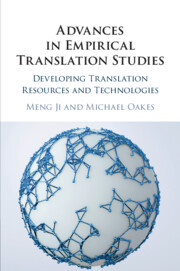Book contents
- Advances in Empirical Translation Studies
- Advances in Empirical Translation Studies
- Copyright page
- Contents
- Figures
- Tables
- Contributors
- Preface
- 1 Advances in Empirical Translation Studies
- 2 Development of Empirical Multilingual Analytical Instruments
- 3 Statistics for Corpus-Based and Corpus-Driven Approaches to Empirical Translation Studies
- 4 The Evolving Treatment of Semantics in Machine Translation
- 5 Translating and Disseminating World Health Organization Drinking-Water-Quality Guidelines in Japan
- 6 Developing Multilingual Automatic Semantic Annotation Systems
- 7 Leveraging Large Corpora for Translation Using Sketch Engine
- 8 Developing Computerised Health Translation Readability Evaluation Tools
- 9 Reordering Techniques in Japanese and English Machine Translation
- 10 Audiovisual Translation in Mercurial Mediascapes
- 11 Exploiting Data-Driven Hybrid Approaches to Translation in the EXPERT Project
- 12 Advances in Speech-to-Speech Translation Technologies
- 13 Challenges and Opportunities of Empirical Translation Studies
- Index
- References
4 - The Evolving Treatment of Semantics in Machine Translation
Published online by Cambridge University Press: 10 June 2019
- Advances in Empirical Translation Studies
- Advances in Empirical Translation Studies
- Copyright page
- Contents
- Figures
- Tables
- Contributors
- Preface
- 1 Advances in Empirical Translation Studies
- 2 Development of Empirical Multilingual Analytical Instruments
- 3 Statistics for Corpus-Based and Corpus-Driven Approaches to Empirical Translation Studies
- 4 The Evolving Treatment of Semantics in Machine Translation
- 5 Translating and Disseminating World Health Organization Drinking-Water-Quality Guidelines in Japan
- 6 Developing Multilingual Automatic Semantic Annotation Systems
- 7 Leveraging Large Corpora for Translation Using Sketch Engine
- 8 Developing Computerised Health Translation Readability Evaluation Tools
- 9 Reordering Techniques in Japanese and English Machine Translation
- 10 Audiovisual Translation in Mercurial Mediascapes
- 11 Exploiting Data-Driven Hybrid Approaches to Translation in the EXPERT Project
- 12 Advances in Speech-to-Speech Translation Technologies
- 13 Challenges and Opportunities of Empirical Translation Studies
- Index
- References
Summary
John Searle and other influential theorists have argued that machine translation (MT) and other natural language processing (NLP) programs can never appreciate meaning in the deepest sense – in other words, that they can never truly exhibit semantics. It is true that MT and many other NLP systems have made steady and impressive progress while use of explicit semantic processing has undergone a rise and fall. It is also true that consensus among researchers on the meaning of meaning has remained elusive. In this chapter, however, we observe renewed interest in semantic representation and processing. Moreover, we foresee gradual adoption of semantic approaches grounded upon audio, visual, or other sensor-based input. We distinguish such perceptually-grounded semantic approaches from most current methods, which have tended to remain perception-free. With respect to philosophical implications, we suggest that perceptually-grounded approaches to automatic natural language processing can display intentionality, and thus foster a truly meaningful semantics. As background for these predictions and suggestions, we survey the role of semantics in machine translation to date in terms of three paradigms: rule-based, statistical, and neural MT. A section on each paradigm discusses its treatment of semantics: rule-based methods have generally emphasized symbolic semantics; statistical methods have generally avoided semantic treatment or employed vector-based semantics; and neural methods have handled meaning as implicit within networks.
Keywords
- Type
- Chapter
- Information
- Advances in Empirical Translation StudiesDeveloping Translation Resources and Technologies, pp. 53 - 76Publisher: Cambridge University PressPrint publication year: 2019
References
- 2
- Cited by



